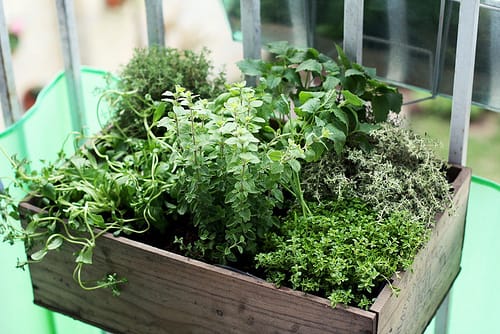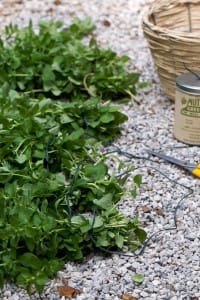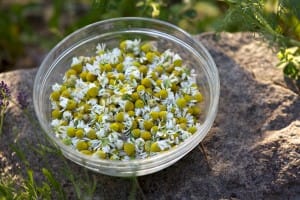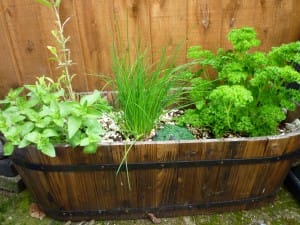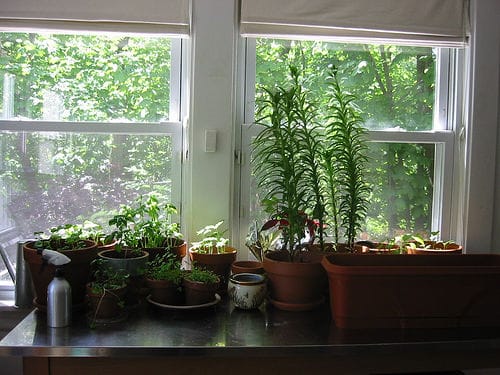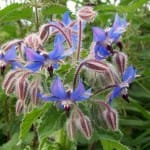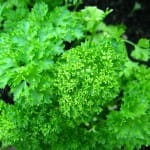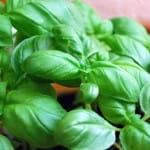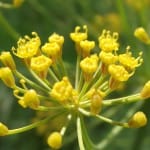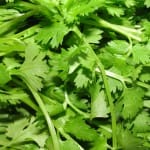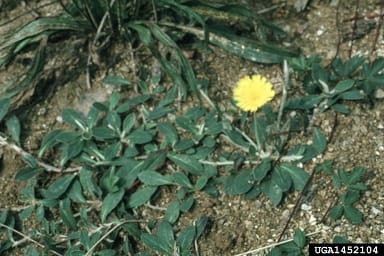Source(s): Wayne McLaurin, Professor Emeritus of Horticulture, The University of Georgia, College of Agricultural and Environmental Sciences
Herbs that can be grown in the South provide numerous ways to decorate and scent homes, yards, and places of business. Some of the following herbs are also edible.
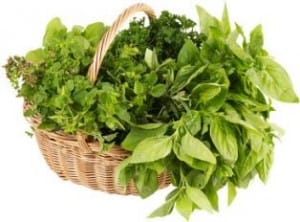
Anise Hyssop (Agastache foeniculum)
A tall perennial with small purple flowers, anise hyssop (neither true anise nor hyssop) blooms in the South throughout the summer. An excellent bee plant, it grows best in a sunny area and may be propagated through seed or root division.
Artemisia (Artemisia abrotanum – Southernwood; Artemisia absinthium – Wormwood)
Artemisias are noted for their grey-green or silver foliage, either ferny or slightly cut leaves. Of the numerous species, southernwood and wormwood are most popularly grown in the Southern herb garden. Artemisias favor full sun, tolerate light shade and soil with some clay. As perennials, artemisias grow woody and leggy. They should be trimmed back in spring and divided every two to three years. Strong-scented artemisias are said to be useful for repelling moths and fleas. They are particularly decorative in the garden as a contrast plant among colors and greens of other plants.
Comfrey (Symphytum officinale)
Though once used as a wound dressing, comfrey in today’s herb garden or landscape is a striking, expansive plant with large leaves and pink flowers sent up on stalks in early summer. It is a perennial that reappears each spring. The plant should be watched for slug infestations. A light mulch will keep its leaves off the ground and create a less desirable habitat for pests. It is propagated primarily by division or root cuttings.
Costmary (Chrysanthemum balsamita). A midsummer bloomer with small yellow flowers, costmary produces large, oblong, fragrant leaves which tend to look scraggly as the season progresses. It is a hardy perennial and is related to
Chrysanthemum parthenium, daisy-like feverfew.
It will spread, though not invasively, through underground rhizomes and should be divided after two or three years.
Hyssop (Hyssopus officinalis)
An attractive perennial border plant with small, dark green leaves, hyssop bears pink, white, or blue flowers in the spring. Hyssop prefers a sandy soil or at least very well-drained soil and plenty of sun. It is propagated through division, cuttings, or seed. The spicy scent of both its flowers and its leaves contributes to potpourris.
Lavender (Lavandula spp.)
From the Latin lavare meaning to wash, lavender is still used today to perfume bath and cosmetic products. Grown from seed (slow to germinate) or cuttings, lavender is one of the most popular plants for the herb garden. The tallest species and probably the best known English lavender (L. angustifolia) is only one of many species including Spanish lavender (L. stoechas) and French lavender (L. dentata). Lavenders require full sun and very well-drained soil. Some herb growers recommend growing lavenders on mounds to ensure drainage. Winter hardy in milder climates, lavender produces white or pale purple to blue-purple flowers and strongly scented needle-like, grey-green leaves. Even the woody stems are fragrant.
Lemon Verbena (Aloysia triphylla)
As it is perhaps the strongest of the lemon-scented herbs, merely brushing by lemon verbena will release a delightful scent. All parts of the plant are scented lemon. Hardy in milder winters, lemon verbena is one of the last of the perennial herbs to leaf out in spring. It grows with abandon, up to 5 feet, and benefits from light pruning. Edible as well as decorative, lemon verbena is also an ideal potpourri plant. It is propagated through cuttings and prefers full sun.
Monarda (Monarda didyma)
Native to America, this tall-growing member of the mint family goes by many names including bergamot, Oswego tea, and bee balm, because it attracts bees. ‘Cambridge Scarlet’ is a cultivar offering bright red flowers in early summer that attract hummingbirds. Monarda leaves have an indefinable, almost lemon scent. Like other members of the mint family, it is a perennial that should be divided about every three years. It may be trimmed back to improve its appearance in late summer.
Mountain Mint (Pycnanthemum pilosum)
A perennial found in abundance in the Appalachian area, mountain mint is a fragrant plant that tolerates shade. About 2 to 3 feet tall, mountain mint develops grey-green leaves at the end of its branches with tiny greenish flowers at the very tip. The plant appears from a distance to have branches ending in white blooms. A popular bee plant, mountain mint needs pruning at least once per summer to control its tendency to grow leggy. Also, mountain mint attracts and provides food for beneficial wasps.
Patchouli (Pogostemon patchouli)
A tropical perennial, patchouli with its exotic Far Eastern fragrance is now available at nursery centers. Patchouli may be grown successfully outdoors in full sun, adequately watered, in fertile soil. When temperatures begin to drop regularly below 65 degrees, it must be brought indoors. An excellent fragrance plant, it may be propagated by seeds, though cuttings are generally used.
Perilla (Perilla frutescens)
This Asian herb, also known as Shisho, is a highly decorative annual garden plant. Direct seeded or transplanted, perilla adapts to full sun or partial shade. The green-leaved variety is a salad herb, but the tall, purple-leaved variety is a striking landscape plant as well. This herb tends to spread from dropped seeds.
Grown by seeding, cuttings, or division, rue has a rich historical tradition. Also known as “Herb of Grace” because it symbolized repentance, rue is today a beautiful ornamental addition to the herb garden. However, its blue-green leaves and yellow flowers in late summer may cause dermatitis in some people. The plant will grow woody with lanky stems if not pruned at least once per summer.
Santolina (Santolina chamaecyparissus)
Santolina is an excellent perennial border plant as it grows between 1 and 2 feet high and is often used in knot gardens. Both gray and green cultivars exist. Santolina produces a strong, perhaps spicy scent when its hard, narrow leaves are crushed. The herb will succumb to heat and overwatering and should be planted in very well drained soil. It is also known as “lavender cotton” and may be used in dried arrangements and in wreathmaking.
Scented Geranium (Pelargonium spp.)
Numerous cultivars are found within this genus, commonly named by their scents — coconut, rose, peppermint, nutmeg, apple, cinnamon, and combinations such as lemon-rose, and others. Most varieties produce small, attractive flowers and leaves that are fragrant when touched. While most are compact, some can grow 2 feet around. They are excellent container plants, and since they are not cold hardy, plants in containers can be moved easily indoors. They will grow in sun or partial shade and prefer sandy soil and minimal watering. Pinched to discourage legginess, they are generally propagated through cuttings.
Soapwort (Saponaria officinalis)
Soapwort, or “bouncing Bet,” is an easy perennial to grow and, unlike most herbs, tolerates moist or dry, poor soil and some shade. It produces white blooms in the summer. Its name comes from the use of its leaves as a mild, sudsing soap-like solution used even in these times for cleaning fine tapestries and other old fabrics (the term “wort” is from the Old English wyrt, meaning root, plant, or herb). It can be propagated from either divisions or seed, and will self-sow.
Stachys (Stachys byzantina)
Perennial stachys, commonly known as “lamb’s ears” for its large, velvety, silvery green leaves, is a beautiful low-growing garden plant producing purple flowers in the early summer. In the same genus as betony, stachys requires minimum water once established; overwatering will cause the plant to “melt” out with deterioration of the leaves, as will shading by other plants. The thick growth also encourages insects on the underside of the leaves. Stachys spreads, though not invasively.
Sweet Woodruff (Galium odoratum)
Sweet woodruff is a favorite herb for shade and makes an attractive ground cover. It may be readily recognized by its narrow, bright-green leaves growing in successive, star-like whorls. The plant is a perennial herb about 6 inches to 8 inches tall.
Tansy (Tanacetum vulgare)
A tall perennial with fern-like foliage, tansy produces yellow button flowers in summer. It grows in full sun and will spread by means of underground rhizomes. Because of its pungent scent, it is sometimes used as an insect repellent. Both leaves and flowers are useful in either fresh or dry arrangements. Formerly used medicinally, tansy is now known to be toxic if ingested.
Yarrow (Achillea millefolium)
Each of the several varieties of yarrow has special characteristics in the landscape, from the fern-like leaves and tall habit of filipendulina to argentea, a smaller, silver-leaved variety. Yarrows are hardy in almost any growing condition, but do best in full sun. They can be propagated by seeding or root division. Yarrows may need to be divided periodically. Remove flowerheads to promote reblooming. The flowers, which include reds, pinks, yellows, and whites, can be cut for their long stalks and dried in bundles for winter arrangements.
Literary Herbs
Poets have used plants to express their thoughts for centuries. Shakespeare wrote of rosemary for remembrance in Hamlet, and about rue, herb of grace, in The Winter’s Tale.
Milton spoke of “sweetest fennel” in Paradise Lost.
The Bible refers to cleansing with hyssop, words bitter as wormwood (artemisia), and fragrance of balm.
Costmary, while not a Biblical herb, was used as a marker in Bibles and as a fragrant herb in churches in colonial time; hence, its name, “Bible Leaf.”
Resource(s):
Herbs in Southern Gardens
Center Publication Number: 263
